TRAVEL TUESDAY
My parents named me Linda. This shocked my grandfather, Josef. He said to my father, “For why you name a girl Linda? In Romania they only name the dogs Linda.” And he meant literal dogs, not the derogatory term used for unattractive girls. Over the years we laughed at this ridiculous notion, especially because of the ubiquity of my name in the 1950s (it was the number one most popular girl’s name from 1947-1952).
I’m part of what I call “The Linda generation.” I can be pretty sure most women I meet named Linda were born within about five years of my birth. Fully one quarter of the girls (nine out of 36) in my grade school graduating class, were named “Linda.”
So what does this have to do with Travel Tuesday? Stick with me.
The morning after visiting my grandfather’s church in Neppendorf, cousin Maria was getting her hair done, so I took an exploratory stroll down a neighborhood street. I heard someone call my name. “Linda.” Surprised I turned and saw this man (at right), whom I approached, introduced myself, and explained my connection to the town. His little dog was nearby and as I bent to pet it, I said, “How cute! What’s his name.” Turned out to be a “her.”
“Linda!” the man replied. I laughed out loud and explained the long-standing family tale.
Shortly after this encounter, we went to the Siebenbürgen genealogical center in Sibiu/Hermannstadt, got Samuel Ebner’s house number and headed to my grandmother’s (Lisi Ebner) home town of Grosspold, hoping to find the Ebner Hof.
At my grandmother’s Lutheran Church, we met Pastor Meitert. I’ve already written about how he showed us the Ebner Family Book, where we discovered how many family deaths my grandmother endured. (see Life and Death Abbreviated. In the last post, (Searching for Home) we traced my grandmother’s family back to my great-great grandparents, the Eders.
After these discoveries, Pastor Meitert removed the Ebner Family pages tucked them under his arm and led us through the town, going literally door-to-door in Grosspold, hoping someone would know where the Ebner Hof was located. We pick up here.
First stop was the Sonnleitner Hof. We pushed open two enormous, thick, wooden gates through which, in previous times, horse and carts probably had passed. (Hof implies more than just a house. It includes the large, enclosed courtyard and land surrounding the home, like a mini-farm, wherein chickens pace, animals are housed, vegetables grown. (see photo)
Frau Sonnleitner was typical of what has become of Germans in Romania. We guessed she was in her sixties, a widow now living alone. All her children have moved to Germany, visiting her once or twice a year. Pfarrer Meitert told us that in 1939, almost two thousand Saxon Germans lived in Grosspold. Only fifty-five remain. Of the 800,000 or so Siebenbürgishe Sachsen, the ethnic Germans that had once lived throughout Transylvania, a mere 20,000, mostly older residents like Frau Sonnleitner, have stayed in Romania. The rest have taken advantage of Germany’s offer of citizenship and have opted to go there where they have better work opportunities and living conditions.
Pastor Meitert showed Frau Sonnleitner the Ebner family record sheets from the Lutheran Church’s Family Book, wondering if she knew the family or where the Ebnerhof, house number 365, might be.
As they spoke, I absorbed the atmosphere of a Hof that was probably similar to the one in which my grandmother’s family had lived 100 years earlier. About 1,000 walnuts lay drying in the sun as mumbling chickens made desultory pecks at loose gravel. Snorting grunts from the back of the Hof got our attention. “Do you have pigs back there?” I asked.
“Yes,” she said, “two big pigs.” Frau Sonnleitner confessed she had no idea where the Ebnerhof lay, but offered to introduce us to her “Schweine.”
The pigs were huge, rooting around in the mud. We asked what they ate. The usual scraps was the expected response, but then she added, “And they really like tile.”
“Tile! You mean like roof tiles?”
“Yes. It’s good for their digestion.” And with that, she picked up several large pieces of terra cotta tile, broke them on the edge of the stall, and tossed them in. The pigs went after them like dogs after a bone–chomping down the pieces in seconds.
We were agape, but then came the final proof that, for those Germans who had remained in Grosspold, little had changed in Siebenbürgen over the past century. Her small dog had been dashing around the Hof, chasing the chickens and sniffing about. Leaning down to pet the dog, I asked, “What’s your dog’s name?”
“Linda!”
One hundred years after my grandparents left Transylvania, the churches still hold their family histories, pigs eat tile, chickens scratch in the Hof, walnuts dry in piles outside, and “Linda” still goes to the dogs.
Please leave your comment below.
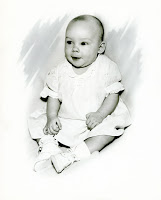
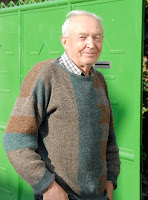
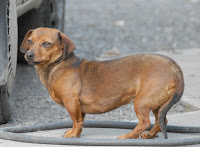
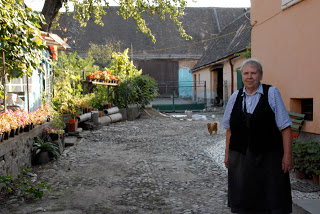
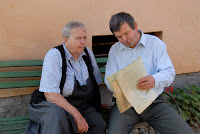
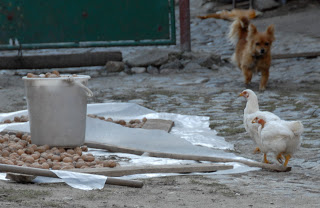
Linda…
We all know that dogs are mans best friend and
that you and Bill have been together for a lifetime and are best friends…so I feel your name is spot on.
Bob
what a sweet story! thanks for sharing.
What a fun post! :-))
Even better, the first word recognition I am getting is “pigfam”.
Oh, my, gotta love the internet!
Nice post. Human interest. well I think Kathy might run second to Linda. lol. I do wonder, how Linda for dogs got started, don’t you?
Hi there, Linda! Thank you for your reply.
I will have both as well, but for SEO reasons, mainly. My website is going to be a very touching one that will also offer value to my target audience, so it’s my “baby” just like my book is.
Cheers,
Jeff
http://theroadtomyself.com
How hilarious! When I was young, people often thought my name was Gretchen – and, of course, the only creatures I knew with that name were dogs…
Hey Linda,
It may be a name for dogs, but doesn’t it mean beautiful? ’nuff said.
Excellent posting, excellent name.
Linda,
That is the name of my best friend born in 1949! But I am Kathy and agree with Rootdigger’s post above. I was once in a Spanish class in high school and five of the girls in that class were named Kathy.
A fun read!
LOVE this! I’m from the Susan generation which must have started the moment Linda dropped from number one. When the hall phone rang on my college dorm floor and someone asked for Susan ten doors would fling open as we’d rush to see which lucky Susan was getting the call. The joke was we were a dime a dozen – the days when a phone call was a dime. Still I’ve only known one dog named Susie – a chihuahua.
Hi Susan,
I had many friends named Susan or iterations of the name (Suzanne, Suzie, Susy, etc.) I’ve seldom met a girl born after the seventies named Linda. It seems the last names of dead presidents are favored today for young girls! It won’t be long before “Madison” and “Monroe” will seem as out-of-fashion as Linda is now and Gladys and Lillian were to my generation. The book, Freakonomics, had a fascinating chapter on how names trickle down from the elite to the regular folk after which the elite abandon those names and come up with something else.
And to Steven, Kathy, Anonymous, Greta, Jeff, Rootdigger, Carol, Gen Story Girl, and Ziobob-so glad you dropped by to comment on Linda and the Dogs! I’m pretty sure I got back to all of you on your own blogs to say thanks as well!
This is funny. My cousins son and his wife recently had a beautiful baby girl Freya, which was also the name of my best friends dog. It’s hard to believe that roof tiles are good for pigs, but I’ve heard they eat anything. At least they do in Australia.
We were equally as blown away by the tile “fressen” (that’s the German word for animals eating — not to be confused with “essen” what people do — unless they’re eating like animals — then the insulting word is fressen).
I’ve heard several dog/human name combos since I posted this. Thanks for dropping by.
I was named Heather about 25 years before it became popular. My Mom’s obstetrician raised Scottish terriers, and he told her that was a dog’s name! Later, when I was student teaching in the 1980s I had three fourth graders named Heather and a Heatherlee in my class!
We should start our own Named for Canines society! Yes, your mom was definitely ahead of her time. I always like the name Heather — has so many lovely associations. I had a lot of students with that name as well.
That is certainly a different slant on our name….LOL…when I turned 60, as a little birthday jab, my youngest brother told me the story of where our “American” name originated….do you know it??? Maybe I will continue your blog with the American tale (tail)
How funny! I’ve never known a single dog named Linda. 🙂
I’m from the “Jennifer” generation. Smack dab in the middle of it – 1976. I think that there must have been at least 3 Jennifers in each of my classes growing up.